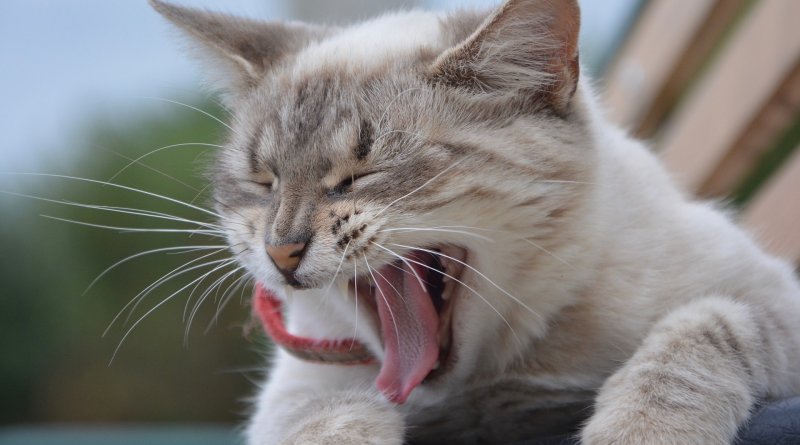Why is My Cat Throwing Up? Types of Cat Vomiting and When to Worry
Last Updated on
Welcome to Wildernesscat’s quick guide to cat puke.
This article is not a substitute for a trip to the veterinarian—seeing a vet is the best way to get an informed, useful assessment of your cat’s vomiting—but it can help you to understand the situation.
Before we go on…
If your cat is lethargic, vomiting blood, exhibiting any behavioral changes, or just “seems off”, take her to a veterinarian immediately. There’s very little a cat blog can do to help you in this situation. You need the guidance, expertise, and personalized care of a veterinarian and you need it as soon as you can get it.
If the situation doesn’t seem urgent, read on. We’re going to talk about how to identify the three different ways that cats throw up and what causes each of these types of vomit. Finally, we’ll briefly go over the ways you can treat chronic and acute vomiting.
The Three Types of Cat Vomiting
Before you even guess why your cat is throwing up, you have to know what type of throwing up you’re witnessing. There are three main ways that cats throw up—regurgitation, hairballs, and true vomiting—and each of them implies a different type of treatment.
How do you know if your cat is vomiting, regurgitating, bringing up hairballs, or doing something else? You listen and look.
Your cat’s vomit gives you clues about what caused it. So does your cat’s behavior before it comes up. If possible, pay attention to your cat when she’s in the process of throwing up. Use your eyes and ears to let your cat tell you what she’s feeling.
Here’s a quick summary of the different ways your cat might throw up, what causes each of these types of vomiting, and what you can do to help.
Type 1: Regurgitation
If your cat is regurgitating her food, she won’t make much noise when she’s doing it. Instead, she’ll quietly yawn open her mouth and the food will pop out looking pretty much the same as it did when it went down. It might have molded to the shape of your cat’s esophagus, so a tubular shape is common.
Most cats regurgitate shortly after a meal. If your cat quietly throws up undigested food minutes after a meal and seems otherwise happy and healthy, she’s probably regurgitating.
Why is my cat throwing up undigested food?
Regurgitation usually happens when something disrupts the early phases of digestion. What that means varies from cat to cat, but specific causes include a stressful eating area, playing too much right after a meal, eating too quickly, and eating too much.
What should you do if your cat is throwing up undigested food or regurgitating?
You can slow down your cat’s eating speed with an interactive feeder, timed feeder, or by feeding her smaller meals throughout the day.
Make eating a calm experience and give her a chance to let the food digest. Some cats regurgitate after eating because they were stressed during the meal. You can help ease the digestive process by feeding your cat when she’s alone without any noisy disruptions and giving her 20 minutes of quiet time after each meal.
Type 2: Hairballs and Other Irritants
Hair, grass, and other foreign bodies may trigger vomiting. Hairballs look like cylinders of hair and they usually arrive in a puddle of clear liquid, sometimes mixed with food.
Cats who go outside may also retch up grass. Depending on when your cat last ate, the grass may come with some food. Usually, you’ll find it in a foamy puddle of clear liquid. If your cat ate some other type of irritant, like a non-poisonous house plant or even a hair tie, this may also trigger the same type of vomiting.
In all of these cases, most cats make a breathy hacking noise while bringing up the irritant. That’s why asthmatic cats are sometimes misdiagnosed with hairballs—the regurgitation sounds more like coughing than vomiting.
Why is my cat throwing up hairballs?
It really depends on the individual cat. Most cats throw up hairballs occasionally. It’s a normal result of spending so much time self-grooming. Hairballs that occur more than a couple of times a month, however, may indicate that your cat has an inflammatory condition or digestive problems.
What should you do if your cat is throwing up hairballs?
Cats who retch hairballs benefit from a simple, wholesome diet that supports overall digestive health. This means that your cat should eat a high-protein, meat-based diet that doesn’t contain a lot of inflammatory additives like carrageenan, dyes, and toxic preservatives.
Some may need extra fiber or lubricating fats. Hairball remedies can help, but we don’t think it’s necessary to keep cats on a regimen of petroleum-based lubricants for the rest of their lives. Use these remedies as a short-term solution while you iron out your cat’s underlying digestive issues or excessive hair consumption.
In addition to dietary changes and supplements, you can prevent hairballs by keeping your cat from eating hair. If you get the right brush and a good routine going, you could remove cupfuls of fur that your cat would otherwise ingest over the course of a week.
Type 3: True Vomiting
While regurgitation is centered around the upper GI tract and esophagus, vomiting comes from lower in the digestive tract and involves partially or fully-digested food rather than undigested food.
Real vomiting has a distinct sound and a unique dance. Vomiting starts with nausea, so your cat will likely drool or rapidly lick her lips and, because she feels nauseous, she may meow loudly or yowl. You’ll hear a deep “gurg-gurg-gurg” sound and see her abdomen contracting.
Why is my cat vomiting?
True vomiting is the most complex of the ways that cats throw up. Asking why your cat is vomiting is almost like asking why your cat isn’t eating as much as she used to. There is a world of reasons why your cat might be exhibiting this behavior. Poisoning, food intolerance, cancer, kidney disease, hyperthyroidism, and even diabetes can make your cat vomit.
Signs that your cat is suffering from a real problem include blood in the vomit, lethargy, abnormally-colored gums, diarrhea, and other signs of illness.
What should you do if your cat is vomiting?
If your cat exhibits other symptoms of illness, fast your cat or switch to a bland diet and see if your veterinarian can help. If your cat is bright-eyed, playful, and otherwise her normal self and the vomiting only happens once or twice, there’s probably no need to visit the veterinarian or do much of anything. Keep watching her and, if nothing else changes, she should be fine.
What if your cat seems otherwise healthy but vomits on a regular basis?
This situation is frustrating and if you’re going through it right now, you’re not alone. Though we don’t know exactly why, chronic vomiting is extremely common among otherwise healthy cats.
Intermittent vomiting that’s not accompanied by signs of illness may be indicative of subclinical pancreatitis, IBD, allergies, or food intolerances.
If you suspect that your cat has a chronic vomiting problem due to any of these issues, request further testing. Blood tests and allergy tests can help you to identify what’s wrong. Allergy tests can be expensive and take a long time to yield results. If you’re on a budget, you might consider the Affordable Pet Test as an economical, expedient way to learn about your cat’s intolerances.
Read our complete review of the Affordable Pet Test.
If you don’t get your cat tested or the testing doesn’t tell you what you need to know, there’s no harm in tinkering with your cat’s diet. Try an ultra-digestible, meat-based diet that doesn’t contain any inflammatory ingredients. If you suspect that your cat has allergies, try an elimination diet to rule out allergens.
In conclusion, there’s no need to worry if your cat regurgitates, has hairballs, or even vomits digested food—occasionally.
But if your cat is throwing up regularly or her vomiting is accompanied by other symptoms of illness, it’s time to contact the veterinarian. Causes of vomiting range from inconsequential to deadly and it can be hard to know where your cat’s condition sits on that spectrum.
If you don’t have access to a veterinarian, consider getting a free veterinarian consultation from PetCoach.co. Through PetCoach’s veterinarian consultation service, you can reach out to verified pet experts and receive personalized advice based on your cat’s unique situation.
You’ll still want to visit an emergency clinic if your cat has been vomiting or having diarrhea for a day or more or exhibits any other symptoms of serious illness.
More resources to help you find out why your cat is throwing up:
- Pet Poison Helpline – Know the Signs of Poisoning in Dogs and Cats
- Vet.Cornell.edu – Gastrointestinal Parasites of Cats
- VCA Hospitals – Gastritis in Cats
- Cornell Feline Health Center – Inflammatory Bowel Disease








